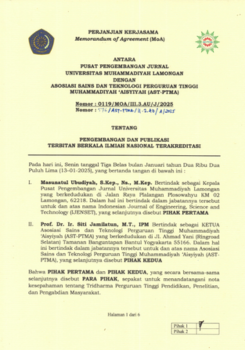APPLICATION OF THE SIMPLE MOVING AVERAGE METHOD FOR FARMING FISH PRICE FORECASTING SYSTEMS
DOI:
https://doi.org/10.38040/ijenset.v1i1.713Abstract
Price is one of the important things that needs to be considered as a determining factor for profit or loss on product sales as a result of price fluctuations which are very difficult to control. Price fluctuations are caused by many factors including weather, stock availability, demand and others. One of the steps to overcome the problem of price fluctuations is to forecast the entry price of fish. Forecasting is the art or science of predicting future events using past data. The purpose of this study is to apply the simple moving average method to estimate the price of farmed fish. The simple moving average method uses a number of actual demand data to generate forecast values for future requests. This method has two special properties, namely to make forecasts that require historical data over a certain period of time, the longer the moving average, the smoother the moving average will be. This study uses data on fish prices (milkfish and tilapia) daily for January 2023. The results show that the Simple moving average produces a very accurate forecast with a MAPE percentage for milkfish of 2% and tilapia of 1.97%.
References
Andriana, A. D., & Susanto, R. (2017). Forecasting the Amount of Tea Production Using the Single Moving Average (SMA) Method. FTIK UNIKOM Scientific Proceedings, 2, 1–6.
Aprillya, M. R., Suryani, E., & Dzulkarnain, A. (2019). The analysis of the quality of paddy harvest yield to support food security: A system thinking approach (case study: East Java). Procedia Computer Science, 161, 919–926. https://doi.org/10.1016/j.procs.2019.11.200
Ardiansyah, H., Rivai, M., & Nurabdi, L. P. E. (2018). Train arrival warning system at railroad crossing using accelerometer sensor and neural network. AIP Conference Proceedings, 1977. https://doi.org/10.1063/1.5042999
Bianto, M. A., Kusrini, K., & Sudarmawan, S. (2020). Design of a Cardiac Disease Classification System Using Naïve Bayes. Creative Information Technology Journal, 6(1), 75. https://doi.org/10.24076/citec.2019v6i1.231
Eko Handoyo, Andharini Dwi Cahyani, & Rika Yunitarini. (2014). Decision Support System for Selection of Regional Superior Products Using the Entropydanelectre II Method (Case Study: Office of Cooperatives, Industry and Trade of Lamongan Regency). Technoscientia Journal of Technology, 7(1), 22–27.
Firman et al. (2016). web-based online library information system. E-Journal of Electrical and Computer Engineering, 18(1), 23. https://doi.org/10.29300/syr.v18i1.1568
Hudaningsih, N., Firda Utami, S., & Abdul Jabbar, W. A. (2020). Comparison of Sales Forecasting of Aknil Pt.Sunthi Sepuri Products Using the Single Moving Average and Single Exponential Methods Smoothing. Journal of Informatics, Technology and Science, 2(1), 15–22. https://doi.org/10.51401/jinteks.v2i1.554
Kusyanto, Suhardi, D., & Awaluddin, R. (2020). Forecasting sales of ceramics using the moving average and exponential smoothing methods in the agus ceramics business. Journal of Accounting and Management Economics, 1(1), 12–21. https://journal.uniku.ac.id/index.php/jeam
Lusiana, A., & Yuliarty, P. (2020). APPLICATION OF FORECASTING METHODS ON ROOF DEMAND at PT X. Innovative Industry: Journal of Industrial Engineering, 10(1), 11–20. https://doi.org/10.36040/industri.v10i1.2530
Maiyendra, N.A. (2019). Designing a Tourism Tour Promotion Information System and Booking a Tour Package for the Kerinci Jambi Region at Cv. Rinai Based Open Source. Jursima, 7(1), 1. https://doi.org/10.47024/js.v7i1.164
Maricar, A.M. (2019). Comparison Analysis of Accuracy Value of Moving Average and Exponential Smoothing for Revenue Forecasting System at Company XYZ. Journal of Systems and Informatics (JSI), 13(2), 36–45. https://www.jsi.stikom-bali.ac.id/index.php/jsi/article/view/193
Prapcoyo, H. (2018a). Forecasting Number of Students. Telematics, 15(01), 66–75.
Prapcoyo, H. (2018b). Forecasting the Number of Students Using the Moving Average. Telematics, 15(1), 67. https://doi.org/10.31315/telematics.v15i1.3069
Pratama, A. A., Agushinta R., D., & Mukhyi, M. A. (2022). Application of the Moving Average Method and Exponential Smoothing for Prediction of Indonesian Export and Import Value. FIFO Scientific Journal, 14(1), 58. https://doi.org/10.22441/fifo.2022.v14i1.006
Rachman, R. (2018). Application of the Moving Average and Exponential Smoothing Methods in Garment Industry Production Forecasting. Journal of Informatics, 5(2), 211–220. https://doi.org/10.31311/ji.v5i2.3309
Rokhmawati, D. R., & Sardjito, S. (2020). Determination of Leading Commodity Types of Aquaculture Fishery Sub Sector in Lamongan Regency. ITS Journal of Science and Art, 8(2). https://doi.org/10.12962/j23373520.v8i2.47284
Saputra, B.D. (2019). a Fuzzy Time Series-Markov Chain Model To Forecast Fish Farming Product. Cursors, 9(4), 129–138. https://doi.org/10.28961/kursor.v9i4.167
Shodiq, M., & Saputra, B. D. (2022). Gray Forecasting Model For Forecasting Aquaculture Fish Prices. 9(6), 1770–1778. https://doi.org/10.30865/jurikom.v9i6.5120
Sinaga, H. D. E., Irawati, N., & Information, S. (2018). Comparison of Double Moving Average with Double Exponential Smoothing in Forecasting. Jurteks, IV(2), 197–204
Downloads
Published
Issue
Section
Citation Check
License
Authors who publish with this journal agree to the following terms:
- Authors retain copyright and grant the journal the right of first publication with the work simultaneously licensed under a Creative Commons Attribution License that allows others to share the work with an acknowledgment of the work's authorship and initial publication in this journal.
- Authors are permitted and encouraged to post their work online (e.g., in institutional repositories or on their website) prior to and during the submission process, as it can lead to productive exchanges, as well as earlier and greater citation of published work (See the Effect of Open Access).
- IJENSET journal by LPPM-UMLA is licensed under a Creative Commons Attribution-ShareAlike 4.0 International License.










